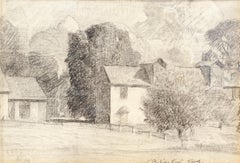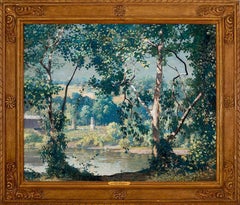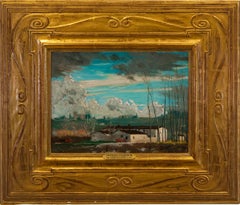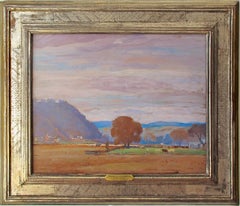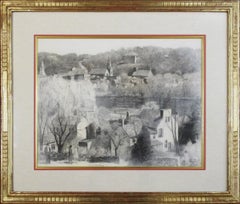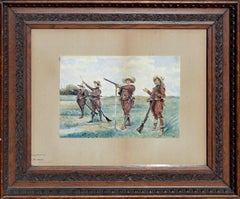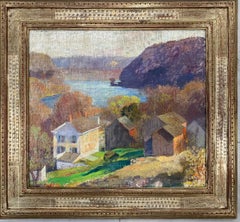Daniel Garber Art
to
15
15
7
7
4
2
2
2
Daniel Garber Original Drawing, from Artist's Estate
By Daniel Garber
Located in Larchmont, NY
Daniel Garber (American, 1880-1958)
Balderstons, c. Early 20th Century
Pencil on paper
7 x 9 in.
Framed: 12 x 4 x 1/2 in.
Titled and initialed lower right: Balderstons, D.G.
Proven...
Category
Early 20th Century American Impressionist Daniel Garber Art
Materials
Paper, Pencil
"Fields in Jersey"
By Daniel Garber
Located in Lambertville, NJ
Jim’s of Lambertville Fine Art Gallery is proud to present this piece by Daniel Garber (1880 - 1958).
One of the two most important and, so far, the most valuable of the New Hope Sc...
Category
Early 1900s American Impressionist Daniel Garber Art
Materials
Oil, Canvas
"Bellosguardo (Florence, Italy)"
By Daniel Garber
Located in Lambertville, NJ
Jim’s of Lambertville Fine Art Gallery is proud to present this piece by Daniel Garber (1880 - 1958).
One of the two most important and, so far, the most valuable of the New Hope Sc...
Category
Early 1900s American Impressionist Daniel Garber Art
Materials
Oil, Board
"Up the Valley"
By Daniel Garber
Located in Lambertville, NJ
In an original Harer frame.
Illustrated in "Daniel Garber Catalogue Raisonne" Vol. II, pg. 271, and in book titled "Blue Chips", pg. 33
Jim’s of Lambertville is proud to offer this artwork by:
Daniel Garber (1880-1958)
One of the two most important and, so far, the most valuable of the New Hope School Painters, Daniel Garber was born on April 11, 1880, in North Manchester, Indiana. At the age of seventeen, he studied at the Art Academy of Cincinnati with Vincent Nowottny. Moving to Philadelphia in 1899, he first attended classes at the "Darby School," near Fort Washington; a summer school run by Academy instructors Anshutz and Breckenridge. Later that year, he enrolled at the Pennsylvania Academy of the Fine Arts. His instructors at the Academy included Thomas Anshutz, William Merritt Chase and Cecilia Beaux. There Garber met fellow artist Mary Franklin while she was posing as a model for the portrait class of Hugh Breckenridge. After a two year courtship, Garber married Mary Franklin on June 21, 1901.
In May 1905, Garber was awarded the William Emlen Cresson Scholarship from the Pennsylvania Academy, which enabled him to spend two years for independent studies in England, Italy and France. He painted frequently while in Europe, creating a powerful body of colorful impressionist landscapes depicting various rural villages and farms scenes; exhibiting several of these works in the Paris Salon.
Upon his return, Garber began to teach Life and Antique Drawing classes at the Philadelphia School of Design for Women in 1907. In the summer of that same year, Garber and family settled in Lumbertville, Pennsylvania, a small town just north of New Hope. Their new home would come to be known as the "Cuttalossa," named after the creek which occupied part of the land. The family would divide the year, living six months in Philadelphia at the Green Street townhouse while he taught, and the rest of the time in Lambertville. Soon Garber’s career would take off as he began to receive a multitude of prestigious awards for his masterful Pennsylvania landscapes. During the fall of 1909, he was offered a position to teach at the Pennsylvania Academy as an assistant to Thomas Anshutz. Garber became an important instructor at the Academy, where he taught for forty-one years.
Daniel Garber painted masterful landscapes depicting the Pennsylvania and New Jersey countryside surrounding New Hope. Unlike his contemporary, Edward Redfield, Garber painted with a delicate technique using a thin application of paint. His paintings are filled with color and light projecting a feeling of endless depth. Although Like Redfield, Garber painted large exhibition size canvases with the intent of winning medals, and was extremely successful doing so, he was also very adept at painting small gem like paintings. He was also a fine draftsman creating a relatively large body of works on paper, mostly in charcoal, and a rare few works in pastel. Another of Garber’s many talents was etching. He created a series of approximately fifty different scenes, most of which are run in editions of fifty or less etchings per plate.
Throughout his distinguished career, Daniel Garber was awarded some of the highest honors bestowed upon an American artist. Some of his accolades include the First Hallgarten Prize from the National Academy in 1909, the Bronze Medal at the International Exposition in Buenos Aires in 1910, the Walter Lippincott Prize from the Pennsylvania Academy and the Potter Gold Medal at the Art Institute of Chicago in 1911, the Second Clark Prize and the Silver Medal from the Corcoran Gallery of Art for “Wilderness” in 1912, the Gold Medal from the Panama-Pacific Exposition in San Francisco of 1915, the Second Altman Prize in1915, the Shaw prize in 1916, the First Altman Prize in 1917, the Edward Stotesbury Prize in1918, the Temple Gold Medal, in 1919, the First William A...
Category
1940s American Impressionist Daniel Garber Art
Materials
Oil, Panel
"Horse Cart"
By Daniel Garber
Located in Lambertville, NJ
Jim’s of Lambertville Fine Art Gallery is proud to present this piece by Daniel Garber (1880 - 1958).
One of the two most important and, so far, the most valuable of the New Hope Sc...
Category
Early 20th Century American Impressionist Daniel Garber Art
Materials
Graphite, Paper
"View of Lambertville"
By Daniel Garber
Located in Lambertville, NJ
Jim’s of Lambertville Fine Art Gallery is proud to present this piece by Daniel Garber (1880 - 1958).
One of the two most important and, so far, the most valuable of the New Hope Sc...
Category
1940s American Impressionist Daniel Garber Art
Materials
Charcoal, Paper
"Spring Valley Willows"
By Daniel Garber
Located in Lambertville, NJ
Jim’s of Lambertville Fine Art Gallery is proud to present this piece by Daniel Garber (1880 - 1958).
One of the two most important and, so far, the most valuable of the New Hope School Painters, Daniel Garber was born on April 11, 1880, in North Manchester, Indiana. At the age of seventeen, he studied at the Art Academy of Cincinnati with Vincent Nowottny. Moving to Philadelphia in 1899, he first attended classes at the "Darby School," near Fort Washington; a summer school run by Academy instructors Anshutz and Breckenridge. Later that year, he enrolled at the Pennsylvania Academy of the Fine Arts. His instructors at the Academy included Thomas Anshutz, William Merritt Chase and Cecilia Beaux. There Garber met fellow artist Mary Franklin while she was posing as a model for the portrait class of Hugh Breckenridge. After a two year courtship, Garber married Mary Franklin on June 21, 1901.
In May 1905, Garber was awarded the William Emlen Cresson Scholarship from the Pennsylvania Academy, which enabled him to spend two years for independent studies in England, Italy and France. He painted frequently while in Europe, creating a powerful body of colorful impressionist landscapes depicting various rural villages and farms scenes; exhibiting several of these works in the Paris Salon.
Upon his return, Garber began to teach Life and Antique Drawing classes at the Philadelphia School of Design for Women in 1907. In the summer of that same year, Garber and family settled in Lumbertville, Pennsylvania, a small town just north of New Hope. Their new home would come to be known as the "Cuttalossa," named after the creek which occupied part of the land. The family would divide the year, living six months in Philadelphia at the Green Street townhouse while he taught, and the rest of the time in Lambertville. Soon Garber’s career would take off as he began to receive a multitude of prestigious awards for his masterful Pennsylvania landscapes. During the fall of 1909, he was offered a position to teach at the Pennsylvania Academy as an assistant to Thomas Anshutz. Garber became an important instructor at the Academy, where he taught for forty-one years.
Daniel Garber painted masterful landscapes depicting the Pennsylvania and New Jersey countryside surrounding New Hope. Unlike his contemporary, Edward Redfield, Garber painted with a delicate technique using a thin application of paint. His paintings are filled with color and light projecting a feeling of endless depth. Although Like Redfield, Garber painted large exhibition size canvases with the intent of winning medals, and was extremely successful doing so, he was also very adept at painting small gem like paintings. He was also a fine draftsman creating a relatively large body of works on paper, mostly in charcoal, and a rare few works in pastel. Another of Garber’s many talents was etching. He created a series of approximately fifty different scenes, most of which are run in editions of fifty or less etchings per plate.
Throughout his distinguished career, Daniel Garber was awarded some of the highest honors bestowed upon an American artist. Some of his accolades include the First Hallgarten Prize from the National Academy in 1909, the Bronze Medal at the International Exposition in Buenos Aires in 1910, the Walter Lippincott Prize from the Pennsylvania Academy and the Potter Gold Medal at the Art Institute of Chicago in 1911, the Second Clark Prize and the Silver Medal from the Corcoran Gallery of Art for “Wilderness” in 1912, the Gold Medal from the Panama-Pacific Exposition in San Francisco of 1915, the Second Altman Prize in1915, the Shaw prize in 1916, the First Altman Prize in 1917, the Edward Stotesbury Prize in1918, the Temple Gold Medal, in 1919, the First William A...
Category
1940s American Impressionist Daniel Garber Art
Materials
Etching
"Birmingham Meeting House"
By Daniel Garber
Located in Lambertville, NJ
Jim’s of Lambertville Fine Art Gallery is proud to present this piece by Daniel Garber (1880 - 1958).
One of the two most important and, so far, the most valuable of the New Hope Sc...
Category
1930s American Impressionist Daniel Garber Art
Materials
Etching
"Bare Tree"
By Daniel Garber
Located in Lambertville, NJ
Jim’s of Lambertville Fine Art Gallery is proud to present this piece by Daniel Garber (1880 - 1958).
One of the two most important and, so far, the most valuable of the New Hope School Painters, Daniel Garber was born on April 11, 1880, in North Manchester, Indiana. At the age of seventeen, he studied at the Art Academy of Cincinnati with Vincent Nowottny. Moving to Philadelphia in 1899, he first attended classes at the "Darby School," near Fort Washington; a summer school run by Academy instructors Anshutz and Breckenridge. Later that year, he enrolled at the Pennsylvania Academy of the Fine Arts. His instructors at the Academy included Thomas Anshutz, William Merritt Chase and Cecilia Beaux. There Garber met fellow artist Mary Franklin while she was posing as a model for the portrait class of Hugh Breckenridge. After a two year courtship, Garber married Mary Franklin on June 21, 1901.
In May 1905, Garber was awarded the William Emlen Cresson Scholarship from the Pennsylvania Academy, which enabled him to spend two years for independent studies in England, Italy and France. He painted frequently while in Europe, creating a powerful body of colorful impressionist landscapes depicting various rural villages and farms scenes; exhibiting several of these works in the Paris Salon.
Upon his return, Garber began to teach Life and Antique Drawing classes at the Philadelphia School of Design for Women in 1907. In the summer of that same year, Garber and family settled in Lumbertville, Pennsylvania, a small town just north of New Hope. Their new home would come to be known as the "Cuttalossa," named after the creek which occupied part of the land. The family would divide the year, living six months in Philadelphia at the Green Street townhouse while he taught, and the rest of the time in Lambertville. Soon Garber’s career would take off as he began to receive a multitude of prestigious awards for his masterful Pennsylvania landscapes. During the fall of 1909, he was offered a position to teach at the Pennsylvania Academy as an assistant to Thomas Anshutz. Garber became an important instructor at the Academy, where he taught for forty-one years.
Daniel Garber painted masterful landscapes depicting the Pennsylvania and New Jersey countryside surrounding New Hope. Unlike his contemporary, Edward Redfield, Garber painted with a delicate technique using a thin application of paint. His paintings are filled with color and light projecting a feeling of endless depth. Although Like Redfield, Garber painted large exhibition size canvases with the intent of winning medals, and was extremely successful doing so, he was also very adept at painting small gem like paintings. He was also a fine draftsman creating a relatively large body of works on paper, mostly in charcoal, and a rare few works in pastel. Another of Garber’s many talents was etching. He created a series of approximately fifty different scenes, most of which are run in editions of fifty or less etchings per plate.
Throughout his distinguished career, Daniel Garber was awarded some of the highest honors bestowed upon an American artist. Some of his accolades include the First Hallgarten Prize from the National Academy in 1909, the Bronze Medal at the International Exposition in Buenos Aires in 1910, the Walter Lippincott Prize from the Pennsylvania Academy and the Potter Gold Medal at the Art Institute of Chicago in 1911, the Second Clark Prize and the Silver Medal from the Corcoran Gallery of Art for “Wilderness” in 1912, the Gold Medal from the Panama-Pacific Exposition in San Francisco of 1915, the Second Altman Prize in1915, the Shaw prize in 1916, the First Altman Prize in 1917, the Edward Stotesbury Prize in1918, the Temple Gold Medal, in 1919, the First William A...
Category
Early 20th Century American Impressionist Daniel Garber Art
Materials
Charcoal, Paper
"Pigs"
By Daniel Garber
Located in Lambertville, NJ
Jim’s of Lambertville Fine Art Gallery is proud to present this piece by Daniel Garber (1880 - 1958).
One of the two most important and, so far, the most valuable of the New Hope Sc...
Category
1940s American Impressionist Daniel Garber Art
Materials
Charcoal
"Lunch at the Stockton Inn"
By Daniel Garber
Located in Lambertville, NJ
Jim’s of Lambertville is proud to offer this artwork.
Signed lower left. Pencil drawing.
Complemented by a hand carved and gilt frame.
Daniel Garber (1880-1958)
...
Category
20th Century American Impressionist Daniel Garber Art
Materials
Paper, Pencil
"Old Barney"
By Daniel Garber
Located in Lambertville, NJ
Jim’s of Lambertville Fine Art Gallery is proud to present this piece by Daniel Garber (1880 - 1958).
One of the two most important and, so far, the most valuable of the New Hope Sc...
Category
Mid-20th Century American Impressionist Daniel Garber Art
Materials
Etching
"Improvidence"
By Daniel Garber
Located in Lambertville, NJ
Jim’s of Lambertville Fine Art Gallery is proud to present this piece by Daniel Garber (1880 - 1958).
One of the two most important and, so far, the most valuable of the New Hope Sc...
Category
1920s American Impressionist Daniel Garber Art
Materials
Etching
"Frances in Braids"
By Daniel Garber
Located in Lambertville, NJ
Jim’s of Lambertville is proud to offer this artwork.
Pastel portrait of artist's granddaughter.
Complemented by original signed Harer frame.
Illustra...
Category
1930s American Impressionist Daniel Garber Art
Materials
Pastel
Harmonville
By Daniel Garber
Located in Missouri, MO
DANIEL GARBER
"Harmonville, Pennsylvania" c. 1925
Etching printed in black ink on wove paper.
7 7/8 x 11 3/4 inches, full margins.
Signed, titled and inscribed "DG imp" in pencil, ...
Category
1920s American Impressionist Daniel Garber Art
Materials
Etching
Related Items
"Arquebusiers En Manoeuvre", After Marchetti
Located in Soquel, CA
Figurative landscape of four infantrymen in formation with their long arquebus guns by Adolphe Ancker (Dutch, 19th Century), after Marchetti. Signed and dated "Adolph Ancker 1888" lo...
Category
1880s American Impressionist Daniel Garber Art
Materials
Watercolor, Paper, Pencil
Garland Studies I
By John Singer Sargent
Located in New York, NY
Image dimensions: 7 ¼ x 10 ½ inches
Framed dimensions: 16 ½ x 20 inches
To produce his murals, Sargent painted monumental canvases in his studios in London and Boston, adhering them...
Category
1920s American Impressionist Daniel Garber Art
Materials
Paper, Pencil
"Old Russell House, " Charles Marion Russell, Western American Drawing
By Charles Marion Russell
Located in New York, NY
Charles Marion Russell (1864 - 1926)
Old Russell House
Pencil on paper
3 1/2 x 6 1/2 inches
Provenance:
Kennedy Galleries, New York
Raydon Galleries, ...
Category
Late 19th Century American Impressionist Daniel Garber Art
Materials
Pencil, Paper
Figure Bending Over
By John Singer Sargent
Located in New York, NY
Image dimensions: 5 ½ x 3 ½ inches
Framed dimensions: 12 ⅛ x 10 ⅜ inches
Inscribed at lower left: JS 220
Our drawing is also referred to as Young Boy Adjusting His Sandal, and is illustrated in the catalogue for Sargent's 1928 exhibition of drawings at Grand Central Art Galleries in New York. It is an example of an early study from life executed c. 1874-8.*
Sargent drew continuously from an early age and had benefited from the emphasis on drawing at the Accademia delle Belle Arti in Florence where he entered the life class in 1870. He arrived in Paris on May 16th, 1874, with a large portfolio of drawings...
Category
1870s American Impressionist Daniel Garber Art
Materials
Paper, Pencil
Old House, Built in 1848
By Gilbert Neumann
Located in Austin, TX
"Old House, Built in 1848" by painter Gilbert F. Neumann
Medium: Oil paint on panel
Size: 9 x 12 inches
Frame Size: 14 x 18.5 inches
A nostalgic painting of ...
Category
20th Century American Impressionist Daniel Garber Art
Materials
Panel, Oil
Gloucester
By Guy Carleton Wiggins
Located in Milford, NH
A fine impressionist harbor scene in Gloucester, Massachusetts by American artist Guy Carleton Wiggins (1883-1962). Wiggins was born in Brooklyn, New York, and had a long and success...
Category
Early 20th Century American Impressionist Daniel Garber Art
Materials
Board, Oil
Miner Hillard Milling Company
By George William Sotter
Located in New York, NY
Signed lower right: G.W. Sotter; on verso: MINER HILLARD / MILLING Co.
Category
Mid-20th Century American Impressionist Daniel Garber Art
Materials
Oil, Board
Planes of the Head
By Lu Haskew
Located in Loveland, CO
"Planes of the Head" by Lu Haskew
Graphite on Paper 14x12" framed, 10x8" image size
ABOUT THE ARTIST:
Lu considered it a must to work with live models once ...
Category
Early 2000s American Impressionist Daniel Garber Art
Materials
Archival Paper, Graphite
Mid 20th Century Canadian snow covered landscape, Halliburton Highlands Ontario
Located in Woodbury, CT
Outstanding Oil on board a snow-covered Canadian landscape of the Haliburton Highlands near Ontario.
Andrew B Phin is a painter, who is listed as a 20th-century Canadian painter of ...
Category
1960s American Impressionist Daniel Garber Art
Materials
Oil, Board
Monterey Coastal Mountains Landscape
By Jack Lynn
Located in Soquel, CA
Gorgeous plein air landscape painting of green fields with California mountains and the coast in the background by Monterey area artist Jack Lynn (American, 20th Century). Unframed. ...
Category
1990s American Impressionist Daniel Garber Art
Materials
Oil, Canvas
Pacific Grove Woods, Mid Century Modern Carmel California Landscape
By Ray Barton
Located in Soquel, CA
Pacific Grove Woods, Mid Century Modern Carmel California Landscape
Beautiful late 1960's landscape painting of a house in the Pacific Grove woods by California artist Ray Barton (Am...
Category
1960s American Impressionist Daniel Garber Art
Materials
Canvas, Oil, Cardboard
H 23 in W 27 in D 3 in
"Study off Newport, Rhode Island" John Singer Sargent Drawing, Impressionism
By John Singer Sargent
Located in New York, NY
John Singer Sargent
Study off Newport, Rhode Island, 1876
Signed in pencil "JS265A" lower left
Pencil on paper
5 x 10 inches
Provenance:
Estate of the artist
Grand Central Art Galleries, New York, 1959
Mr. William H. Bender Jr
Sotheby's New York, September 19, 1987
Private Collection 1987-2000
Mark Borghi Fine Art Inc., circa 2002
Private Collection (acquired from the above), New York
Recognized as the leading portraitist in England and the United States at the turn of the century, John Singer Sargent was acclaimed for his elegant and very stylish depictions of high society. Known for his technical precocity, he shunned traditional academic precepts in favor of a modern approach towards technique, color and form, thereby making his own special contribution to the history of grand manner portraiture.
A true cosmopolite, he was also a painter of plein air landscapes and genre scenes, drawing his subjects from such diverse locales as England, France, Italy and Switzerland. In so doing, Sargent also played a vital role in the history of British and American Impressionism.
Sargent was born in Florence in 1856. He was the first child of Dr. Fitzwilliam Sargent, a surgeon from an old New England family, and Mary Newbold Singer, the daughter of a Philadelphia merchant. His parents were among the many prosperous Americans who adopted an expatriate lifestyle during the later nineteenth century. Indeed, Sargent's family traveled constantly throughout the Continent and in England, a mode of living that enriched Sargent both culturally and socially. He ultimately became fluent in French, Italian and German, in addition to English.
Having developed an interest in drawing as a boy, Sargent received his earliest formal instruction in Rome in 1869, where he was taught by the German-American landscape painter Carl Welsch. Following this, he attended the Accademia di Belle Arti in Florence during 1873-74.
In the spring of 1874, Sargent's family moved to Paris, enabling him to continue his training there. He soon entered the studio of Charles-Emile-Auguste Carolus-Duran. In contrast to most French academic painters, Carolus-Duran taught his students to paint directly on the canvas, capturing the essence of his subject through relaxed brushwork, a tonal palette and strong chiaroscuro. Although Sargent also spent four years studying drawing under Léon Bonnat at the Ecole des Beaux-Arts, it was Carolus-Duran's approach that would form the aesthetic basis of his style.
Upon his teacher's advice, Sargent also traveled to Spain and Holland to study the work of old master painters such as Diego Velázquez and Frans Hals, both of whom also employed deft, fluid techniques.
In 1876, Sargent made his first visit to the United States, claiming his American citizenship and visiting the Philadelphia Centennial Exposition. One year later, he spent the summer in Cancale, in France's Brittany region, where he painted outdoors, applying Carolus-Duran's strategies to portrayals of fishing folk on sunlit beaches. His reputation in Paris was established in 1878 when his Oyster Gatherers of Cancale (1878; Corcoran Gallery of Art, Washington, D.C.) won an Honorable Mention at that year's Salon.
During the early 1880s, Sargent began making painting trips abroad, working in Venice in 1880 and 1882, where he painted street scenes and interiors notable for their brilliant play of light and shadow. He also embarked on what would be a lucrative career as a portraitist, producing such well known works as The Daughters of Edward Darley Boit (1882; Museum of Fine Arts, Boston).
His early commissions also included an image of Madame Pierre Gautreau. A renowned beauty and member of Parisian society, Madame Gautreau was known for her bold, unorthodox approach towards fashion. In her portrait, entitled "Madame X" (1884; Metropolitan Museum of Art, New York), Sargent effectively captured her distinctive aura. However, his daring realism, coupled with fact that he portrayed a diamond shoulder strap falling off one of her shoulders, caused such an uproar that his career in France was seriously compromised.
As a result of the controversy surrounding "Madame X,"Sargent left Paris in 1886, settling permanently in London. He subsequently flourished in the English capital, becoming the leading portrait painter to the upper classes. Those who shared Sargent's sense of refinement and sophistication, as well as his international viewpoint, were especially drawn to his fashionable French style.
In addition to patronage from such prominent British families as the Wertheimers and the Marlboroughs, Sargent received an equal number of American commissions, many of them secured by artists and architects he had met during his student days in Paris, among them painters J. Carroll Beckwith and Julian Alden Weir and architect Stanford White. On a painting tour to America during 1887-1888, he portrayed members of notable families from Boston and New York, including Mrs. Jacob Wendell and Elizabeth Allen...
Category
1870s Impressionist Daniel Garber Art
Materials
Paper, Pencil, Graphite
Previously Available Items
Spring Valley, New Hope School, American Impressionist Landscape with Figures
By Daniel Garber
Located in Doylestown, PA
"Spring Valley" by Pennsylvania Impressionist and New Hope School painter Daniel Garber is an 19" x 25" charcoal on paper, regional landscape drawing with house and figures. It is in...
Category
Early 20th Century American Impressionist Daniel Garber Art
Materials
Charcoal, Archival Paper
H 29 in W 35 in D 1 in
"From Carey's Hill"
By Daniel Garber
Located in Lambertville, NJ
Jim’s of Lambertville is proud to offer this artwork by:
Daniel Garber (1880-1958)
One of the two most important and, so far, the most valuable of the New Hope School Painters, Da...
Category
1940s American Impressionist Daniel Garber Art
Materials
Canvas, Oil
"Sand Warf"
By Daniel Garber
Located in Lambertville, NJ
Jim’s of Lambertville is proud to offer this artwork.
Signed lower right.
Daniel Garber (1880-1958)
One of the two most important and, so far, the most valuable of the N...
Category
1920s American Impressionist Daniel Garber Art
Materials
Etching
"The Kimball Farm"
By Daniel Garber
Located in Lambertville, NJ
Signed lower center.
Complemented by a hand carved and gilt frame.
Exhibited at Art Alliance, 1918.
Illustrated in "Daniel Garber Catalog Raisonne", p. 115.
Daniel Garber (1880...
Category
1910s American Impressionist Daniel Garber Art
Materials
Oil, Board
"The Delaware"
By Daniel Garber
Located in Lambertville, NJ
Signed on the Verso.
Complemented by a hand carved and gilt frame.
Illustrated in "Daniel Garber Catalog Raisonne", p. 105.
Daniel Garber (1880-1958)
One of the two ...
Category
1910s American Impressionist Daniel Garber Art
Materials
Board, Oil
Carversville Church
By Daniel Garber
Located in Lambertville, NJ
Charcoal on laid paper
Featuring a signed Ben Badura frame.
One of the most important Pennsylvania Impressionist/ New Hope School painters. He was...
Category
20th Century Impressionist Daniel Garber Art
Materials
Charcoal
"The Sheep Pen at Cuttalossa"
By Daniel Garber
Located in Lambertville, NJ
Oil on tin Toleware tray.
Illustrated in "New Hope for American Art" and "Daniel Garber Catalog Raisonne", p.437
Daniel Garber (1880-1958)
One of the two mo...
Category
1930s American Impressionist Daniel Garber Art
Materials
Metal
River House
By Daniel Garber
Located in Lambertville, NJ
Edition of 50.
One of the most important Pennsylvania Impressionist/ New Hope School painters. One of Garber's many talents was etching, he created a series of approximately 50 diff...
Category
1930s Daniel Garber Art
Materials
Etching
Mary Franklin Garber Sewing
By Daniel Garber
Located in Lambertville, NJ
One of the most important Pennsylvania Impressionist/ New Hope School painters. He was a fine draftsman, creating a large body of work on paper, mostly in charcoal. Illustrated in "N...
Category
20th Century Daniel Garber Art
September Morning
By Daniel Garber
Located in Lambertville, NJ
farm animals landscape, signed lower right
Category
20th Century Daniel Garber Art
Materials
Oil, Board
Barn Ramp
By Daniel Garber
Located in Lambertville, NJ
*Original Stanford White design frame
Category
20th Century Impressionist Daniel Garber Art
Materials
Oil, Panel
Blue and Silver
By Daniel Garber
Located in Lambertville, NJ
Category
20th Century Daniel Garber Art
Materials
Oil, Board
Daniel Garber art for sale on 1stDibs.
Find a wide variety of authentic Daniel Garber art available for sale on 1stDibs. You can also browse by medium to find art by Daniel Garber in etching, paper, charcoal and more. Much of the original work by this artist or collective was created during the 20th century and is mostly associated with the Impressionist style. Not every interior allows for large Daniel Garber art, so small editions measuring 9 inches across are available. Customers who are interested in this artist might also find the work of Louis Oscar Griffith, Robert Hallowell, and Childe Hassam. Daniel Garber art prices can differ depending upon medium, time period and other attributes. On 1stDibs, the price for these items starts at $4,575 and tops out at $993,750, while the average work can sell for $28,125.
